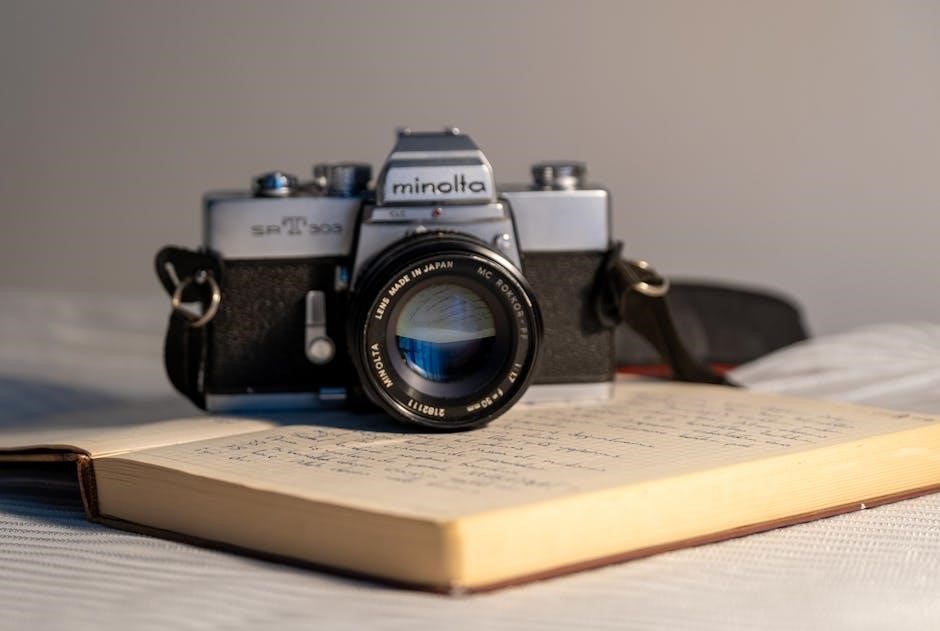Timothy Corrigan’s A Short Guide to Writing About Film offers a concise introduction to analyzing and writing about cinema, blending theoretical insights with practical writing strategies.
Key Concepts in Film Analysis
In A Short Guide to Writing About Film, Timothy Corrigan emphasizes essential concepts for analyzing films, such as mise-en-scène, cinematography, editing, and sound. These elements help students understand how visual and auditory components shape meaning. Narrative structure and character development are also highlighted as critical for interpreting storytelling. Corrigan stresses the importance of identifying themes and motifs, encouraging students to explore how films reflect cultural or psychological contexts. By mastering these concepts, learners gain a deeper appreciation of cinema and develop a vocabulary for critical analysis. The guide bridges theory and practice, making complex ideas accessible while fostering analytical writing skills tailored to film studies.
The Importance of Developing a Vocabulary for Film Criticism
Timothy Corrigan’s guide underscores the necessity of building a robust vocabulary for film criticism, enabling students to articulate their observations effectively. A strong command of terminology allows for precise analysis, distinguishing elements like composition, lighting, and camera angles. This vocabulary bridges the gap between subjective reactions and objective critique, enhancing the clarity and depth of written arguments. By introducing key terms and concepts, Corrigan empowers students to engage with films on a more analytical level, fostering a deeper understanding of cinematic techniques and their impact. Developing this language is not just about describing films but about interpreting their artistic and cultural significance, making it a cornerstone of successful film criticism and writing.

The Writing Process in Film Studies

Timothy Corrigan’s guide emphasizes moving from observation to analysis, teaching students to structure ideas clearly and support arguments with evidence from films.
Preparing to Watch and Analyze Films
Preparing to analyze films involves pre-viewing research, such as studying the director’s background and the film’s historical context. During viewing, focus on key elements like cinematography, dialogue, and themes. Take detailed notes on scenes, characters, and motifs. Afterward, reflect on how these components contribute to the film’s meaning. Corrigan’s guide emphasizes the importance of close observation and critical thinking. Developing a vocabulary for film criticism is essential to articulate insights effectively. This process not only enhances understanding but also equips students to approach films as texts worthy of in-depth analysis. By systematically breaking down the film, learners can uncover its underlying messages and structure their analysis coherently.
Structuring Essays: From Ideas to Final Draft
Corrigan’s guide emphasizes the importance of organizing ideas coherently when writing about films. Start by brainstorming key themes and techniques observed in the film. Develop a clear thesis statement that guides the essay’s focus. Use an outline to structure your analysis, ensuring each paragraph addresses a specific aspect of the film. When drafting, incorporate detailed examples and quotes from the film to support your arguments. Revise your work to refine your ideas and strengthen your critical perspective. By following this structured approach, students can transform their observations into a compelling and well-supported essay. Corrigan’s methods help learners master the transition from initial thoughts to a polished final draft.

Film Terminology and Theoretical Frameworks
Corrigan’s guide introduces essential film terminology and major theoretical frameworks, enabling students to critically analyze cinematic elements and explore deeper meanings in films effectively;
Essential Terms for Film Analysis
Corrigan’s guide emphasizes mastering key film terminology to enhance analytical writing. Terms like mise-en-scène, cinematography, editing, and sound are explored in depth. Understanding these concepts allows students to critically deconstruct films, focusing on visual composition, camera techniques, and narrative structure. The text also highlights the importance of diegetic and non-diegetic elements, as well as montage and long takes. By familiarizing readers with these terms, Corrigan provides a foundation for insightful film analysis, enabling writers to articulate their observations clearly and effectively. This vocabulary is crucial for developing a nuanced understanding of cinema and expressing ideas persuasively in written critiques.
Introducing Major Film Theories
Corrigan’s guide provides an overview of major film theories, such as auteur theory, genre studies, and feminist film theory. These frameworks help students analyze films through different lenses, exploring themes like directorial style, cultural context, and social representation. The text also introduces theories like formalism and realism, encouraging readers to consider how films convey meaning through visual and narrative techniques. By explaining these theories in an accessible way, Corrigan equips writers with tools to deepen their critical understanding of cinema. This section bridges theory and practice, enabling students to apply these concepts to their own analyses and critiques, fostering a more sophisticated approach to film study and writing.

Practical Examples and Applications
Corrigan’s guide offers practical examples, such as analyzing scenes from Inception and The Avengers, to demonstrate how to apply theoretical concepts to real films, enhancing critical writing skills.
Case Studies: Analyzing Popular Films
Corrigan’s guide emphasizes the importance of analyzing popular films to develop critical thinking and writing skills. By examining movies like Inception and The Avengers, students learn to identify visual motifs, character development, and cultural context. These case studies demonstrate how to apply theoretical concepts to real-world examples, making complex ideas accessible. Corrigan encourages students to focus on specific scenes, dialogue, and cinematography to support their arguments. This practical approach helps learners move beyond surface-level analysis, fostering deeper engagement with films. The guide also provides structured exercises to refine writing techniques, ensuring students can effectively communicate their insights. Through these case studies, Corrigan bridges the gap between theory and practice, empowering students to become skilled film analysts and writers.

Developing Original Ideas and Organizing Them Effectively
Corrigan’s guide emphasizes the importance of cultivating original ideas through close film analysis and critical thinking. He suggests starting with specific observations about a film’s visuals, dialogue, and themes, then connecting these to broader cultural or theoretical contexts. To organize ideas effectively, Corrigan recommends outlining essays with clear introductions, thematic body paragraphs, and concise conclusions. He also advocates for revising drafts to refine arguments and clarify language. By providing practical exercises and examples, such as analyzing scenes from Inception or The Avengers, Corrigan helps students transform raw observations into coherent, insightful essays. This structured approach ensures that ideas are both creative and logically presented.

The Impact of Corrigan’s Guide
Corrigan’s guide has revolutionized film education, providing students and educators with a foundational tool for critical analysis and writing. Its clear structure and practical insights have made it indispensable.
Legacy and Influence in Film Education
Timothy Corrigan’s A Short Guide to Writing About Film has become a cornerstone in film education, widely adopted in courses for its clear, accessible approach. The book bridges film theory and practical writing, offering students the tools to analyze films critically. Its emphasis on developing a vocabulary for criticism and structuring essays has empowered learners to engage deeply with cinema. Educators praise its ability to make complex concepts understandable, fostering a new generation of thoughtful film scholars and critics. The guide’s influence extends beyond academia, inspiring broader discussions about film’s cultural and artistic significance. Its enduring popularity underscores its lasting impact on how we teach and learn about film.
Student Success Stories and Feedback
Students and educators alike have praised Timothy Corrigan’s A Short Guide to Writing About Film for its transformative impact on film studies; Many students report that the book’s practical advice and clear structure helped them develop critical thinking and writing skills; Feedback highlights how the guide enables learners to analyze films more effectively, with some noting improved grades and a deeper appreciation for cinema. The book’s accessible language and focus on vocabulary-building have been particularly praised. Students also appreciate the real-world examples and case studies, which make complex concepts relatable. Overall, the guide has proven invaluable for those seeking to excel in film studies and beyond, fostering a lifelong engagement with film analysis and criticism.